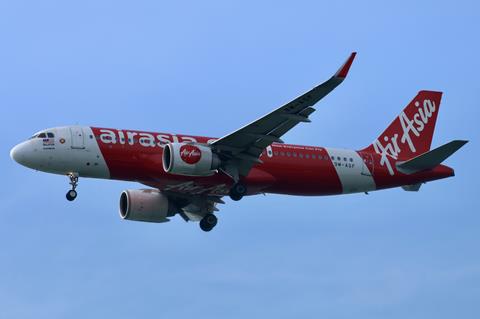Low-cost operators AirAsia Group and AirAsia X saw an increase in revenue in what they note has traditionally been a low season, with travel demand remaining strong amid network and fleet growth.
AirAsia, which is the process of being divested from parent Capital A, disclosed a positive EBITDA of MYR578 million ($130 million) for the three months ended 30 September, up about 50% year on year.

Revenue for the quarter grew 15% to MYR4.5 billion “despite being a seasonally slow quarter”, the airline group states. AirAsia also cites “favourable” fuel prices and the strengthening of the Malaysian Ringgit against the US Dollar among reasons for an improvement in its earnings.
AirAsia Aviation head Bo Lingam says the group is “optimistic” about its year-end outlook, and is boosting its fleet to meet demand.
The airline group, which has units in Malaysia, Indonesia, the Philippines, Cambodia and Thailand, grew its fleet to 221 aircraft, of which 181 were operational.
By the end of the year, Lingam says the group will be taking delivery of five new Airbus A321neos, to be placed in its Thai and Malaysian carriers.
“We expect to maintain high load factors exceeding 85% and robust average fares, driven by year-end festivities,” he adds.
Capital A expects to complete the divestment of AirAsia to AirAsia X in early 2025, paving the way for the formation of a single aviation group with short and medium-haul operations.
AirAsia X reported a positive EBITDA of MYR76 million, down from the year-ago’s MYR132 million. The airline says the “normalising” of its earnings was expected, given the reversal of provisions for travel vouchers in the third quarter of 2023.
Still, revenue grew 23% year on year to MYR795 million, driven by a 20% uptick in scheduled flight revenues, and a significant increase in ancillary revenues.
AirAsia X carried more than 1 million passengers during the quarter, up 34% year on year, while passenger load factor grew four percentage points to 84%.
Airline chief Benyamin Ismail says: “The company’s network continues to deliver solid performance metrics as passenger load for our most popular routes scaled about 90% even in softer travel seasons.”
Ismail notes that the airline is “fast approaching” full fleet reactivation, with one more stored aircraft left. It is also at the “concluding stage” of negotiations for an additional Airbus A330 to join the fleet in early 2025.


























